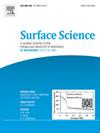不同堆叠方式的二维ZnO双分子层的可调谐电子结构
IF 1.8
4区 化学
Q3 CHEMISTRY, PHYSICAL
引用次数: 0
摘要
近年来,二维氧化锌材料因其良好的性能、化学稳定性和机械强度而引起了广泛的研究关注。这些特殊的性质使它们不仅具有科学意义,而且在光电子学、光子学和传感器方面也有很大的技术应用。本文基于HSE06势第一性原理计算,研究了不同堆叠方式ZnO双分子层的原子结构和电子性能。结果表明,在所有考虑的构型中,ab层是能量最有利的构型。ab -堆垛是机械和动态稳定的。使用HSE06电势计算的带隙为2.88 eV,使用PBE电势计算的带隙为1.45 eV。此外,我们还发现可以通过双层堆积类型以及双轴应变和界面距离的影响来调节能带隙。通过调整ZnO双分子层的几何结构或施加外部应变或改变界面距离来调节ZnO双分子层的能带隙,可以在各种技术领域激发新的应用。本文章由计算机程序翻译,如有差异,请以英文原文为准。

Tunable electronic structures of two-dimensional ZnO bilayers with different stacking
Two-dimensional ZnO materials have recently attracted widespread research attention for their promising properties, chemical stability, and mechanical strength. These special properties make them not only imply a scientific interest but also indicate great technological applications in optoelectronics, photonics, and sensors. Herein, based on the first-principles calculations with the HSE06 potential, the atomic structures and electronic properties of ZnO bilayer with different stacking are investigated. The results demonstrate that AB-stacking is the most energetically favorable configuration among all those considered. The AB-stacking is mechanically and dynamically stable. The calculated band gap is 2.88 eV using the HSE06 potential and 1.45 eV using the PBE potential. Moreover, we found that it is possible to modulate the energy bandgap both by the type of bilayer stacking and by the effect of the biaxial strain and interfacial distance. The ability to tune the energy bandgap in ZnO bilayers by adjusting their geometric configuration or applying an external strain or changing the interfacial distance could inspire new applications in various technological fields.
求助全文
通过发布文献求助,成功后即可免费获取论文全文。
去求助
来源期刊

Surface Science
化学-物理:凝聚态物理
CiteScore
3.30
自引率
5.30%
发文量
137
审稿时长
25 days
期刊介绍:
Surface Science is devoted to elucidating the fundamental aspects of chemistry and physics occurring at a wide range of surfaces and interfaces and to disseminating this knowledge fast. The journal welcomes a broad spectrum of topics, including but not limited to:
• model systems (e.g. in Ultra High Vacuum) under well-controlled reactive conditions
• nanoscale science and engineering, including manipulation of matter at the atomic/molecular scale and assembly phenomena
• reactivity of surfaces as related to various applied areas including heterogeneous catalysis, chemistry at electrified interfaces, and semiconductors functionalization
• phenomena at interfaces relevant to energy storage and conversion, and fuels production and utilization
• surface reactivity for environmental protection and pollution remediation
• interactions at surfaces of soft matter, including polymers and biomaterials.
Both experimental and theoretical work, including modeling, is within the scope of the journal. Work published in Surface Science reaches a wide readership, from chemistry and physics to biology and materials science and engineering, providing an excellent forum for cross-fertilization of ideas and broad dissemination of scientific discoveries.
 求助内容:
求助内容: 应助结果提醒方式:
应助结果提醒方式:


